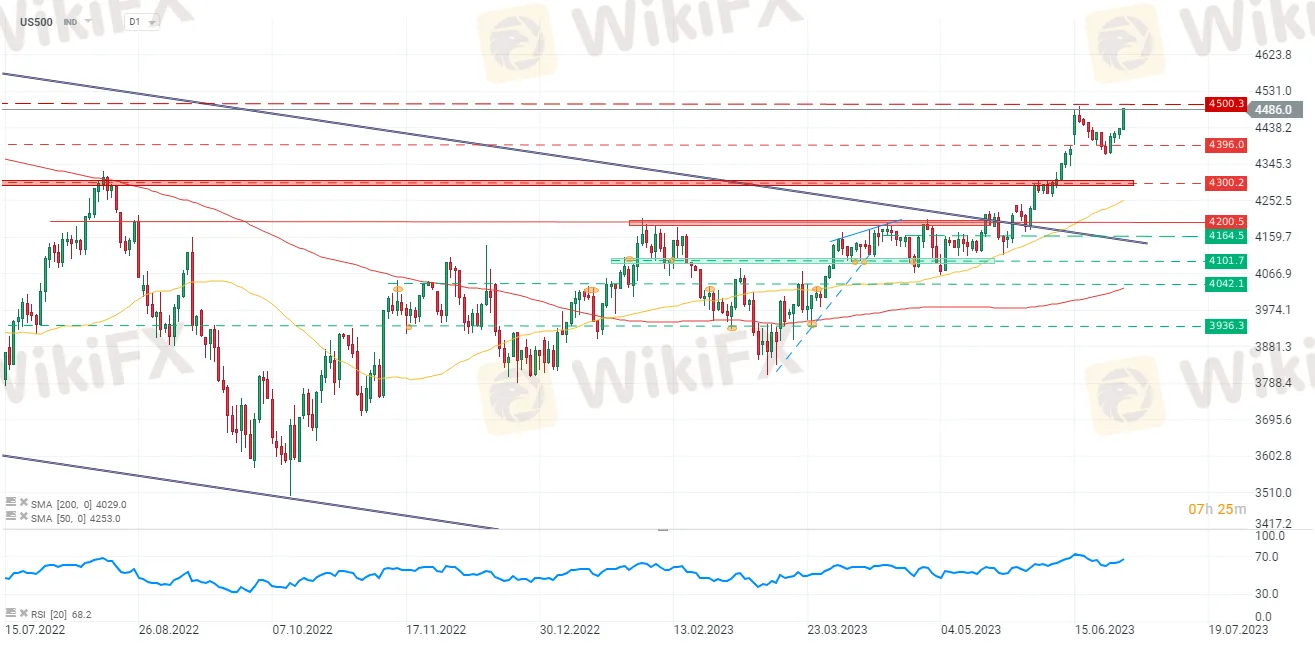US Open: Wall Street bulls take the stage!
Abstract:U.S. stock indexes opened on a positive note as the latest PCE data indicated a decrease in inflation, easing concerns about potential interest rate hikes.

• Wall Street opens higher as PCE data reveals lowest inflation in over 2 years
• S&P 500 is up 1.0%, and Nasdaq Composite gains 1.1%
• Headline PCE shows a modest 0.1% increase in May, while year-over-year price increase slows to 3.8%
U.S. stock indexes opened on a positive note as the latest PCE data indicated a decrease in inflation, easing concerns about potential interest rate hikes. The Dow Jones Industrial Average climbed 0.5%, the S&P 500 rose 0.8%, and the Nasdaq Composite saw a gain of 1.1%.
The PCE deflator, the Federal Reserve's favored inflation gauge, slowed to 3.8% in May, accompanied by stagnant consumer spending, indicating a potential loss of momentum in the economy. The core PCE reading also softened to 4.6%, while services inflation, excluding housing and energy services, experienced a welcome deceleration. These figures led to increased futures gains and the reversal of losses in benchmark Treasuries, as market speculation suggested reduced pressure on the Fed for multiple interest rate hikes by the end of 2023.
On the other hand, in the euro-area, core inflation accelerated in June, posing a setback for the European Central Bank (ECB) and potentially strengthening its determination to raise interest rates next month. The measure of underlying consumer-price gains rose to 5.4%, while headline inflation reached 5.5%, both slightly higher compared to the previous month.

US500 index, currently trading at 4490 points, has shown a significant 1.2% increase on june 30. It recently experienced a bounce from the support level at 4400, indicating a potential shift in momentum. As the index approaches the 4500 level, it is important to monitor its ability to break through this resistance. A successful break of 4500 could potentially pave the way for further gains towards the next level at 4550.

Read more

SC Urges Malaysians To Stay Alert As Scam Complaints Double Since 2020
Malaysia’s Securities Commission warns that complaints about unlicensed investment activities have doubled in five years—3,602 cases in 2024 and 2,039 in H1 2025—highlighting increasingly sophisticated scams targeting even professionals and seniors. Schemes often mimic legitimacy, then block withdrawals via “compliance” or “maintenance” excuses. The core defense is pre-investment verification and ongoing risk control.

Warning: FinPros Finds New Excuses to Block Withdrawals
Recently, reports have surfaced online exposing yet another withdrawal scandal involving FinPros, a forex broker that claims to be regulated by the Cyprus Securities and Exchange Commission (CySEC). According to the report from the victim, FinPros froze her legitimate profit of USD 197, citing a bizarre reason: “suspected collusion with other violators during trading.”

How Do You Earn Money in November 2025?
The global forex market continues to evolve rapidly, and November 2025 is proving to be another active month for traders worldwide. With $7.6 trillion in daily trading volume, forex remains the most liquid financial market, which offers countless opportunities for profit. But how exactly do traders earn money in forex trading this month, and what strategies are working in today’s market environment? Let’s explore how forex traders are making profits in November 2025.

More than £100,000 was fined! Firm advisor banned by FCA for financial crime.
The UK Financial Conduct Authority (FCA) has taken decisive action against a financial professional for insider dealing, underscoring its firm stance against market abuse and dishonest conduct within the financial industry.
WikiFX Broker
Latest News
US and UK Sanction Cambodia-Based Prince Group Over $16B Scam
UAE Launches Sixth 'Caution' Campaign to Combat Forex and Online Investment Fraud
David Stockman On How The Fed's Money Printing Broke American Industry... And What Comes Next
Forex24 Faces CySEC Fine for Late Compliance Filing
One Wrong Move Wiped Out a Government Retiree’s Lifetime Savings
"Our Business Has Died": Texas Services Sector Sentiment Slumps Further In October
OctaFX Forex Brokerage $318 million Fraud Case in India: Authorities Arrest Pavel Prozorov!
How Filipinos Can Recover Funds from Crypto Scams Abroad
Top Tips to Avoid Forex Margin Calls and Protect Your Capital
FCA Daily Alert: Checkout FCA Consumer Warning List
Rate Calc


